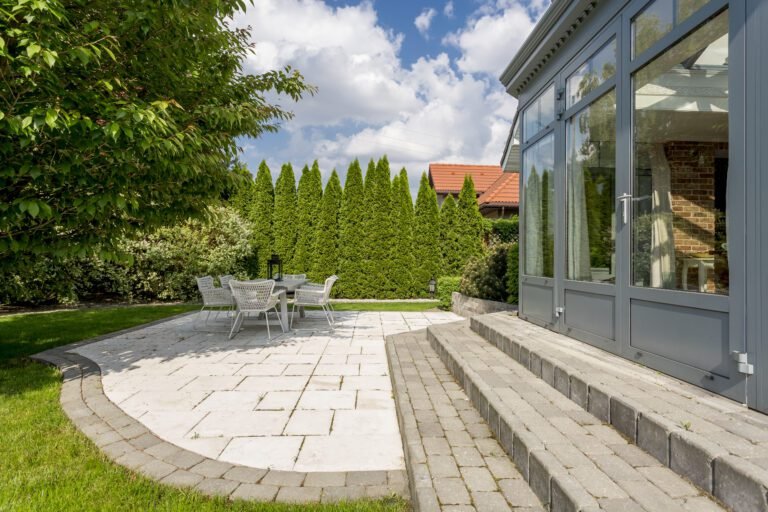Stone has long been a cornerstone of outdoor design. Its enduring appeal lies not only in its visual appeal but also in its durability and versatility. Whether it’s a stone pathway winding through your garden or a rugged stone wall marking the boundary of your outdoor space, stone can be the perfect addition to nearly any landscape. It adds a timeless quality to outdoor spaces, effortlessly blending beauty with functionality.
In this article, we explore why stone continues to be a popular choice for landscape and outdoor design, from its aesthetic value to its practical benefits. We’ll also take a closer look at the various types of stone, how they can be used, and how to incorporate them into your outdoor spaces.
The Timeless Appeal of Stone
One of the primary reasons stone has remained a preferred material for outdoor design is its aesthetic value. Unlike synthetic materials that can wear or fade over time, stone only becomes more beautiful with age. Its natural color variations and textures give it a unique charm that is difficult to replicate.
Stone’s appeal also comes from its enduring beauty. Over centuries, it has stood the test of time in various forms of architecture and landscaping. From ancient Roman roads to modern-day patio designs, stone remains a symbol of craftsmanship and elegance. Its permanence offers peace of mind for homeowners looking to create outdoor spaces that last, both in function and style.
Types of Stone Commonly Used in Outdoor Design
When it comes to outdoor spaces, not all stones are created equal. The type of stone you choose will depend on the specific needs of your landscape, as well as your design preferences. Here are some of the most popular stone types used in landscaping:
- Flagstone: This versatile stone is commonly used for patios, walkways, and garden paths. It has a natural, flat shape that makes it easy to create smooth, even surfaces. Flagstone is available in various colors and textures, making it a go-to option for many outdoor projects.
- Granite: Known for its durability, granite is often used for outdoor countertops, seating areas, and heavy-duty outdoor surfaces. Its dense composition makes it highly resistant to the elements, and its polished finish adds a touch of sophistication to any outdoor space.
- Limestone: This softer stone is ideal for retaining walls and garden borders. While not as durable as granite, it offers a smooth finish and a neutral color palette, allowing it to blend seamlessly with natural surroundings.
- Slate: Known for its rich texture and deep color, slate is often used for flooring and outdoor tiles. It provides a sophisticated yet rustic look, perfect for creating a modern garden patio or an outdoor seating area.
Each type of stone offers unique benefits, so it’s essential to consider how they’ll complement your space and withstand outdoor conditions. Selecting the right stone can enhance your landscape’s overall design and longevity.
The Versatility of Stone in Outdoor Spaces
One of the most compelling reasons to incorporate stone into your outdoor design is its versatility. Stone can be used in a variety of ways to transform your outdoor space, whether you’re aiming for a grand, elegant look or something more natural and rustic.
Pathways and Patios: Stones like flagstone, slate, and granite are perfect for creating durable, visually appealing pathways and patios. These hardscaping elements add structure to your landscape, guiding visitors through your yard while providing a sturdy, long-lasting surface.
Retaining Walls and Garden Borders: Stone is an excellent material for building retaining walls and garden borders. These structures not only serve practical purposes—such as preventing soil erosion and defining garden beds—but they also add an aesthetic dimension to your landscape.
Water Features: Incorporating stone into water features, such as fountains, ponds, or waterfalls, adds natural beauty and texture to the design. Stones can be used to line the edges of ponds or create rock gardens around water features, enhancing their organic appeal.
By using stone in these varied ways, you can elevate the design of your outdoor space while ensuring durability and functionality. Whether it’s a small backyard or a large estate, stone can fit seamlessly into nearly every landscape.
Durability and Maintenance of Stone in Outdoor Spaces
When choosing materials for your outdoor design, durability is an important consideration. Stone excels in this regard. Unlike wood, which can rot or warp, or synthetic materials that may fade or crack over time, stone remains intact and beautiful for decades. Its solid, natural composition allows it to withstand harsh weather conditions, from intense sun to freezing temperatures.
In addition to its longevity, stone requires minimal maintenance. It doesn’t need to be repainted or replaced as often as other materials. Depending on the type of stone, occasional cleaning with water or a mild detergent is usually sufficient to keep it looking its best.
Some stones, such as granite and slate, are naturally resistant to staining and weathering, making them ideal for outdoor surfaces that see frequent use, such as patios or seating areas. Other stones, like limestone, may need sealing to prevent moisture from penetrating and causing damage, but the maintenance required is still relatively low compared to other materials.
Patio Hardscaping: A Key Element of Outdoor Design
When it comes to patio design, stone is an excellent choice for hardscaping. Patio hardscaping refers to the use of non-living materials, such as stone, brick, or concrete, to create functional outdoor areas. A stone patio can serve as the focal point of your outdoor space, providing a durable, low-maintenance area for entertaining, dining, or relaxing.
Stone patios also blend beautifully with nature. Unlike concrete or other artificial materials, stone can mimic the look of natural landscapes, creating a harmonious flow between your home and garden. With a variety of colors, textures, and shapes available, you can create a patio that complements your home’s style while standing up to the elements.
Stone’s Role in Sustainable Landscaping
Stone is also an eco-friendly option for outdoor design. Unlike synthetic materials, natural stone doesn’t require extensive processing or manufacturing, which means less energy consumption and fewer carbon emissions. Additionally, stone is often sourced locally, reducing transportation costs and environmental impact.
Using stone in your landscape can also help mitigate the heat island effect. Certain types of stone, such as slate and granite, can absorb and dissipate heat, helping to keep outdoor spaces cooler during hot weather. This is particularly useful in areas with intense summers, as it can reduce the need for artificial cooling in outdoor spaces.
How to Incorporate Stone into Your Outdoor Space
Incorporating stone into your landscape doesn’t have to be a daunting task. Start by choosing the right type of stone for your project and consider the space’s function. Do you need a sturdy patio for outdoor dining? A winding stone path through your garden? Or a retaining wall to define your garden beds?
Once you’ve chosen your stone, consider whether you’ll install it yourself or hire a professional. Some projects, such as small garden borders or simple walkways, can be tackled by DIY enthusiasts, while larger installations, like stone patios or retaining walls, might require professional help to ensure proper installation.
Conclusion
Stone remains a timeless, versatile material for outdoor design, offering unmatched durability, beauty, and functionality. Whether used in pathways, patios, water features, or retaining walls, stone adds an enduring appeal to any outdoor space. Its natural beauty, low maintenance requirements, and eco-friendly qualities make it a smart choice for homeowners looking to create long-lasting, aesthetically pleasing landscapes. Incorporating stone into your outdoor design can enhance your space for years to come, making it a valuable investment in both form and function.


































